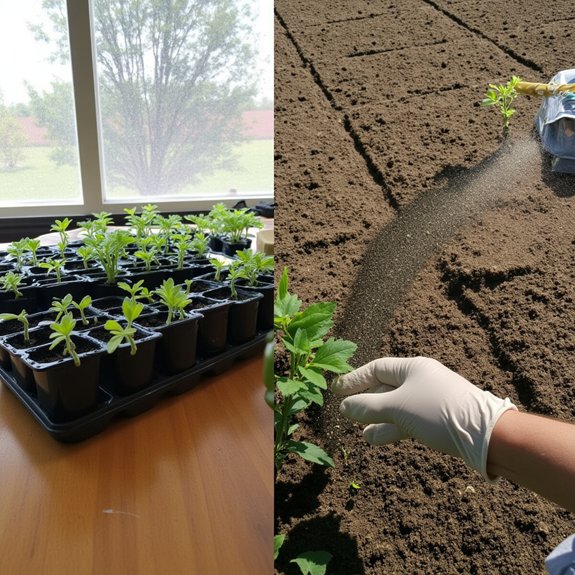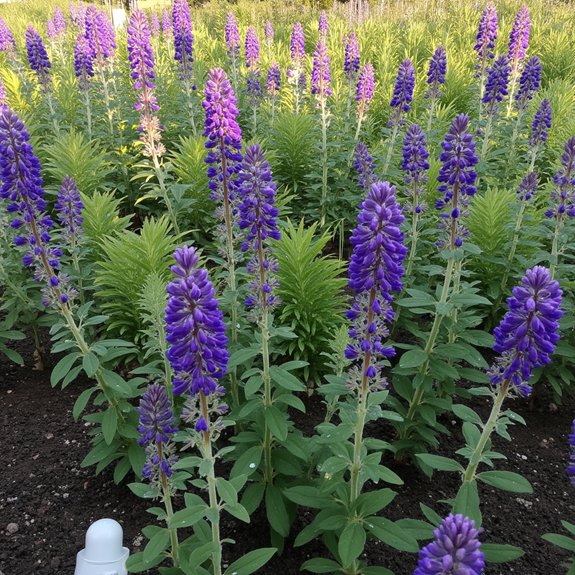Gardeners who master larkspur cultivation can expect blooms lasting 6-8 weeks, considerably longer than most annual flowers. These towering spikes, reaching 3-8 feet tall, transform ordinary gardens into dramatic displays with their distinctive helmet-shaped petals. However, many enthusiasts struggle with germination rates below 30% because they skip one essential step. The secret lies in understanding larkspur’s wild origins and mimicking nature’s harsh winter conditions, a process that separates successful growers from those watching empty garden beds.
Contents
- 1 Understanding Larkspur Characteristics and Growing Zones
- 2 Seed Propagation and Cold Stratification Techniques
- 3 Indoor Vs Outdoor Sowing Methods
- 4 Optimal Planting Conditions and Soil Preparation
- 5 Watering Requirements and Sunlight Needs
- 6 Plant Maintenance and Bloom Management
- 7 Pest Control and Disease Prevention
- 8 Creative Garden Uses and Harvesting Tips
Understanding Larkspur Characteristics and Growing Zones

While many gardeners know larkspur for its striking blue spires, these Mediterranean natives actually produce blooms in red, violet, and white too. These versatile larkspur varieties thrive across USDA zones 2-11, making them accessible to gardeners in nearly every climate. The diverse larkspur colors emerge in early spring, creating stunning vertical displays that deer and rabbits won’t touch.
What makes them particularly appealing is their drought resistance once established. They’re also the official birth flower of July, adding sentimental value to summer gardens. However, gardeners should handle them carefully since all plant parts contain toxins that can irritate skin.
Seed Propagation and Cold Stratification Techniques
Growing larkspur from seed requires understanding their unique germination needs, particularly the cold stratification process that mimics winter conditions. Gardeners should begin with proper seed collection techniques, gathering seeds from drying pods when they crack open naturally.
Effective stratification methods involve pressing seeds into damp starting mix, then refrigerating them for 1-2 weeks while maintaining consistent soil moisture. This cold treatment breaks seed dormancy and guarantees reliable germination.
After stratification, gardeners in zones 2-5 should start seeds indoors a month before the last frost, while those in zones 6-11 can sow directly outdoors in sunny locations.
Indoor Vs Outdoor Sowing Methods

After completing cold stratification, gardeners face an essential decision between indoor and outdoor sowing methods that’ll determine their larkspur’s success rate. Indoor benefits include controlled conditions and better germination rates, especially for zones 2-5 where gardeners should start seeds a month before last frost. Use individual pots for healthier root development, maintain consistent moisture, then transplant after frost danger passes. Outdoor challenges involve weather unpredictability, but zones 6-11 can direct sow successfully. Simply scatter stratified seeds in sunny locations, cover lightly, and keep soil moist for approximately thirty days until germination occurs naturally.
Optimal Planting Conditions and Soil Preparation
Once gardeners have decided between indoor and outdoor sowing, they’ll need to create the perfect growing environment for their larkspur seeds to thrive. These Mediterranean natives prefer well-draining, nutrient-rich soil that’s loose and aerated. Heavy clay or waterlogged soil types spell disaster for larkspur roots, so sandy loam works best.
pH levels should range from slightly acidic to neutral, ideally between 6.0-7.0. Poor drainage causes root rot, while compacted soil stunts growth. Amend heavy soils with coconut husk or river sand for better drainage. Add organic compost to boost nutrients and improve soil structure before planting.
Watering Requirements and Sunlight Needs

Larkspur’s water and light requirements differ greatly between seedlings and mature plants, making timing and technique more important than frequency. Young transplants need consistent moisture through deep, slow morning watering until established. Mature plants become drought tolerant, requiring less attention.
For ideal sunlight duration, provide 6-8 hours of direct sun daily. In extremely hot climates, afternoon shade prevents water evaporation and reduces disease risk. Avoid overhead watering to minimize fungal problems.
Watering frequency should focus on morning sessions rather than evening moisture. Deep, thorough watering beats frequent shallow applications every time.
Plant Maintenance and Bloom Management
While larkspur plants require minimal daily attention, strategic maintenance during key growth periods guarantees the most vibrant blooms and healthy plant development. Effective bloom longevity techniques include deadheading spent flowers immediately after petals fade, which encourages a second flush of colorful blooms within 4-6 weeks.
Smart pruning strategies involve cutting drooping stalks back to healthy growth points, then staking them carefully to avoid disturbing shallow roots. Remove entire stems after blooming finishes to prevent unwanted self-seeding throughout the garden.
Always wear gloves when handling any plant parts, since all larkspur components contain toxic compounds that irritate skin.
Pest Control and Disease Prevention
Beyond maintaining healthy blooms, gardeners must watch for common pests that target larkspur plants throughout the growing season. Aphids cluster on stems and leaves, appearing as tiny green or black insects. Pest identification techniques include checking undersides of leaves weekly and looking for sticky honeydew residue. Organic pest solutions work effectively without harsh chemicals. Remove aphids by hand or spray with neem oil every three days until eliminated. Slugs leave telltale slime trails and chewed foliage. Set beer traps near affected plants, replacing liquid every two days. Introducing ladybugs provides natural aphid control throughout summer months.
Creative Garden Uses and Harvesting Tips
Although many gardeners focus solely on growing techniques, larkspur’s versatility extends far beyond basic cultivation into creative landscaping and practical harvesting opportunities. These towering blooms excel in cottage gardens, wildflower borders, and mixed plantings where their 3-6 foot height creates dramatic backdrops.
For garden arrangements, harvest stems early morning when blooms are partially open, cutting at 45-degree angles underwater. Professional floral design benefits from larkspur’s sturdy stalks and vibrant colors. They last 5-7 days in arrangements when properly conditioned.
Container gardening works well with dwarf varieties, while tall cultivars anchor perennial borders effectively, creating stunning vertical elements.
